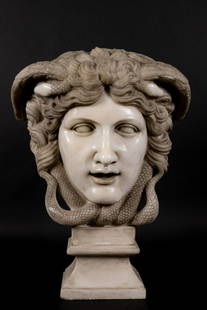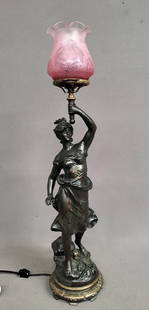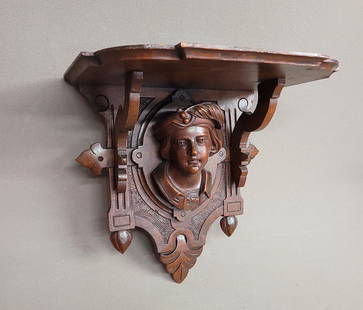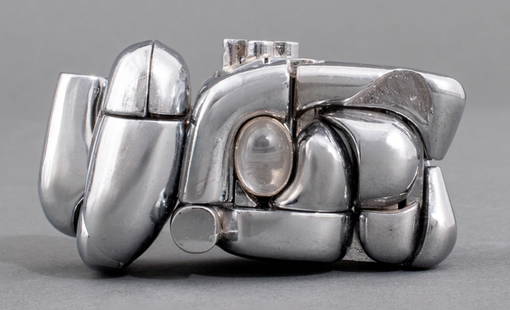
A RARE WHITE MARBLE HEAD OF A BEARDED SAGE, LAOZI Northern Qi-Sui dynasty, 6th century
Similar Sale History
View More Items in Sculptures & Carvings
Related Sculptures & Carvings
More Items in Sculptures & Carvings
View MoreRecommended Art
View More





Item Details
Description
A RARE WHITE MARBLE HEAD OF A BEARDED SAGE, LAOZI
Northern Qi-Sui dynasty, 6th century
Finely carved with a benevolent expression emanating from half-closed eyes, high cheeks and plump jowls set off by a straight nose, pursed lips and elegantly shaped beard, over a thick, tapered neck carved with three characteristic folds and framed by long, pendant ears, the fine-grain stone smoothly polished, with traces of black pigment remains.
12 7/16in (32cm) high
Footnotes:
北齊至隋 大理石髯須老子頭像
Provenance:
Matthews Gallery, New York, 1971
Baron F. Rolin collection, Brussels, since 1971
Christie's Paris, 25 November 2002, lot 263
Galerie Jacques Barrère S.A., Paris, 2003
來源:
紐約Matthews Gallery畫廊,1971年
布魯塞爾Baron F. Rolin收藏,1971年入藏
巴黎佳士得,2022年11月25日,拍品編號263
巴黎Galerie Jacques Barrère藝廊,2003年
The present sculpture may be one of the finest early images of Laozi, a historic figure from the Warring States period (around 6th century B.C.) that later deified as the leading figure of Daoism the religion. As K. Schipper opens the essay 'Taoism: the Story of the Way' in the catalogue of exhibition organized by the Art Institute of Chicago, Taoism and the Arts of China, Chicago, 2000, pp. 33-55:
'Taoism is the foremost indigenous religion of China and one of the world's oldest mystical and liturgical traditions. The name of Taoism comes from Tao (Dao), a word that means 'road' or 'way': a way to follow, a way of thought, a method, and a principle. The Tao is seen as the everlasting principle at the origin of the universe. It permeates and transcends all beings; it is at the origin of all transformations. According to Chinese tradition, the Tao existed before the world was born out of the primordial chaos (hundun). The Tao brought forth the world, and all beings naturally belong to the Tao. Therefore, at its most fundamental level, the name Taoism does not refer to a god or a founding figure, but the a universal principle. Nonetheless, the story of Taoism is inextricably linked to the figure called Laozi (Lao-Tzu), the sage who first revealed the Way to us.'
Images of deified Laozi existed as early as the 5th century and often appeared side-by-side with Buddha figures on steles. As Daoism evolved and formalized, the iconography of Laozi was recognized by his bearded chin, monk's cap, and a fan in his hand. It is difficult to find Laozi images from the 6th century, but one can compare examples from the early 7th century and see the resemblance with the present example: two carved stone Daoist triads dated A.D. 623 and A.D. 665, in the Museum of Fine Arts, Boston, accession numbers 10.308 and 07.743 respectively; a gilt bronze standing figure of Laozi in the collection of the Nelson-Atkins Museum of Art, bequest of Lawrence Sickman and attributed to the early 7th century, accession number F88-37/51.
The present example shows all characteristics of a Northern Qi-Sui dynasty sculpture: the arched brows, slender half-closed eyes, elongated nose, pursed lips, simple hairline, and the elegant shape of the beard framing the full face. The fine-grain white marble used for this sculpture suggests an origin of Hebei province, where the finest white marble Buddhist figures were commissioned by the Northern Qi rulers. Compare, for example, a large white marble head of bodhisattva Avalokitesvara with very similar rendering of the facial features and the serene expression, in the collection of the Art Institute of Chicago, illustrated on the museum's website and by E. Pearlstein and J.T. Ulak, Asian Art in the Art Institute of Chicago, Chicago, 1993, p. 148, with illustrations on pp. 38-39, attributed to the Northern Qi-Sui dynasty.
Northern Qi-Sui dynasty, 6th century
Finely carved with a benevolent expression emanating from half-closed eyes, high cheeks and plump jowls set off by a straight nose, pursed lips and elegantly shaped beard, over a thick, tapered neck carved with three characteristic folds and framed by long, pendant ears, the fine-grain stone smoothly polished, with traces of black pigment remains.
12 7/16in (32cm) high
Footnotes:
北齊至隋 大理石髯須老子頭像
Provenance:
Matthews Gallery, New York, 1971
Baron F. Rolin collection, Brussels, since 1971
Christie's Paris, 25 November 2002, lot 263
Galerie Jacques Barrère S.A., Paris, 2003
來源:
紐約Matthews Gallery畫廊,1971年
布魯塞爾Baron F. Rolin收藏,1971年入藏
巴黎佳士得,2022年11月25日,拍品編號263
巴黎Galerie Jacques Barrère藝廊,2003年
The present sculpture may be one of the finest early images of Laozi, a historic figure from the Warring States period (around 6th century B.C.) that later deified as the leading figure of Daoism the religion. As K. Schipper opens the essay 'Taoism: the Story of the Way' in the catalogue of exhibition organized by the Art Institute of Chicago, Taoism and the Arts of China, Chicago, 2000, pp. 33-55:
'Taoism is the foremost indigenous religion of China and one of the world's oldest mystical and liturgical traditions. The name of Taoism comes from Tao (Dao), a word that means 'road' or 'way': a way to follow, a way of thought, a method, and a principle. The Tao is seen as the everlasting principle at the origin of the universe. It permeates and transcends all beings; it is at the origin of all transformations. According to Chinese tradition, the Tao existed before the world was born out of the primordial chaos (hundun). The Tao brought forth the world, and all beings naturally belong to the Tao. Therefore, at its most fundamental level, the name Taoism does not refer to a god or a founding figure, but the a universal principle. Nonetheless, the story of Taoism is inextricably linked to the figure called Laozi (Lao-Tzu), the sage who first revealed the Way to us.'
Images of deified Laozi existed as early as the 5th century and often appeared side-by-side with Buddha figures on steles. As Daoism evolved and formalized, the iconography of Laozi was recognized by his bearded chin, monk's cap, and a fan in his hand. It is difficult to find Laozi images from the 6th century, but one can compare examples from the early 7th century and see the resemblance with the present example: two carved stone Daoist triads dated A.D. 623 and A.D. 665, in the Museum of Fine Arts, Boston, accession numbers 10.308 and 07.743 respectively; a gilt bronze standing figure of Laozi in the collection of the Nelson-Atkins Museum of Art, bequest of Lawrence Sickman and attributed to the early 7th century, accession number F88-37/51.
The present example shows all characteristics of a Northern Qi-Sui dynasty sculpture: the arched brows, slender half-closed eyes, elongated nose, pursed lips, simple hairline, and the elegant shape of the beard framing the full face. The fine-grain white marble used for this sculpture suggests an origin of Hebei province, where the finest white marble Buddhist figures were commissioned by the Northern Qi rulers. Compare, for example, a large white marble head of bodhisattva Avalokitesvara with very similar rendering of the facial features and the serene expression, in the collection of the Art Institute of Chicago, illustrated on the museum's website and by E. Pearlstein and J.T. Ulak, Asian Art in the Art Institute of Chicago, Chicago, 1993, p. 148, with illustrations on pp. 38-39, attributed to the Northern Qi-Sui dynasty.
Buyer's Premium
- 27.5% up to $25,000.00
- 26% up to $1,000,000.00
- 20% above $1,000,000.00
A RARE WHITE MARBLE HEAD OF A BEARDED SAGE, LAOZI Northern Qi-Sui dynasty, 6th century
Estimate $50,000 - $70,000
2 bidders are watching this item.
Shipping & Pickup Options
Item located in New York, NY, usSee Policy for Shipping
Payment

TOP



















































































